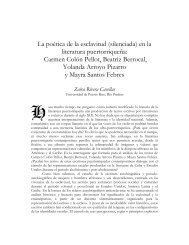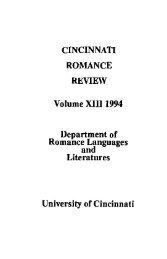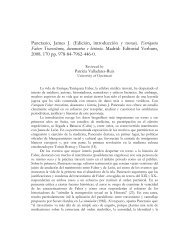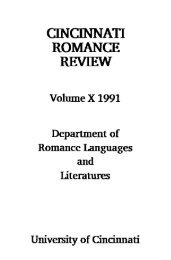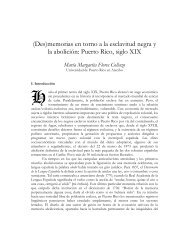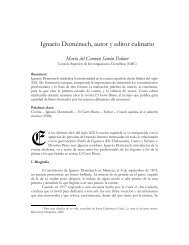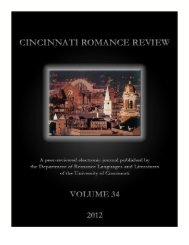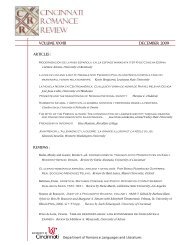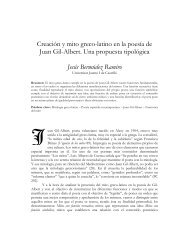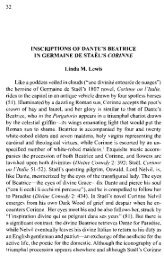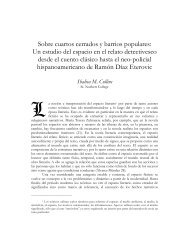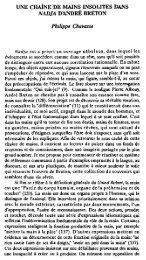Volume 30 (2011) - Cincinnati Romance Review
Volume 30 (2011) - Cincinnati Romance Review
Volume 30 (2011) - Cincinnati Romance Review
Create successful ePaper yourself
Turn your PDF publications into a flip-book with our unique Google optimized e-Paper software.
126 DOSINDA GARCÍA ALVITE<br />
parallel with human speech, it has been traditional in African cultures that they dialogue<br />
with that speech. As Dearling indicates, “African languages operate on two levels:<br />
rhythmic speech and tonal inflexion. Combined, these may be interpreted by differentlypitched<br />
drums or single log drums capable of producing more than one pitch, any<br />
ambiguities becoming clear by intelligent appreciation of the context” (215). In the case<br />
being analyzed, although Morgades’ Antígona is written and probably performed in<br />
Spanish, a language with characteristics different from her native one, the similarities of<br />
the coordination between human speech and drum language recall the Africancenteredness<br />
of the play, even if the resulting effects might not reach the same<br />
complementariness as it could be expected were Spanish to be substituted by the Fang<br />
or Bubi languages, spoken in Equatorial Guinea. Finally, in primarily oral societies,<br />
African peoples make and listen to music that is intimately bound to the visual and<br />
dramatic arts as well as the larger fabric of life (Martin and O’Meara 257). Messages are<br />
usually enhanced by the use of song, dance, drama, drums and horns, and the use of<br />
these is a learned skill, just as are the literacy skills of writing or web communication<br />
(Mushengyezi 111). The use of talking drums in the play impress upon the audience the<br />
importance of this style of transmitting information, still popular in an African context.<br />
Indeed, the fact that drums talk while the play is being performed probably expedites<br />
the effectiveness with which the central message is communicated for an African<br />
audience who, used to this traditional way of using drums in rituals and celebrations of<br />
importance, will focus their attention in them and their dialogue with the performance.<br />
The importance of orality is also stressed in Morgades’s Antígona by the high<br />
proportion of lines the chorus has in relation to other characters. Certainly, although the<br />
idea of the chorus might not be very familiar to a contemporary audience, according to<br />
Bacon “it is a natural human phenomenon that occurs in some form in many societies,<br />
including our own, as well as in that of ancient Greece,” and its function is to indicate<br />
the wide significance of the enacted event, in order to involve the audience in the<br />
meaning and sometimes the consequences (8). The alternation between “I” and “we”<br />
which is characteristic of choral song is seen in the play in the dialogue between “voces”<br />
(chorus) and Antígona, between “voces” and president, and more frequently between<br />
the chorus and the purported audience of the play. It is in this communal spirit that the<br />
drama ends:<br />
Voces: Y ví un Nuevo cielo y una nueva tierra; porque el cielo anterior y<br />
la tierra anterior han pasado, y el mar de sangre ya no existe. Vi también<br />
una limpia y sana ciudad. Oí una voz que decía al pueblo: mientras vivas<br />
bajo Mi Ley no serás destruido… (Antígona 433)<br />
This final paragraph presents a hopeful view of the future and an idealistic<br />
perception of human’s existence and spirituality. Because the “voces” or choir declare<br />
Antigona’s mission and dreams as their own, it seems that the ideals she fought for can<br />
<strong>Cincinnati</strong> <strong>Romance</strong> <strong>Review</strong> <strong>30</strong> (Winter <strong>2011</strong>): 117-129.



